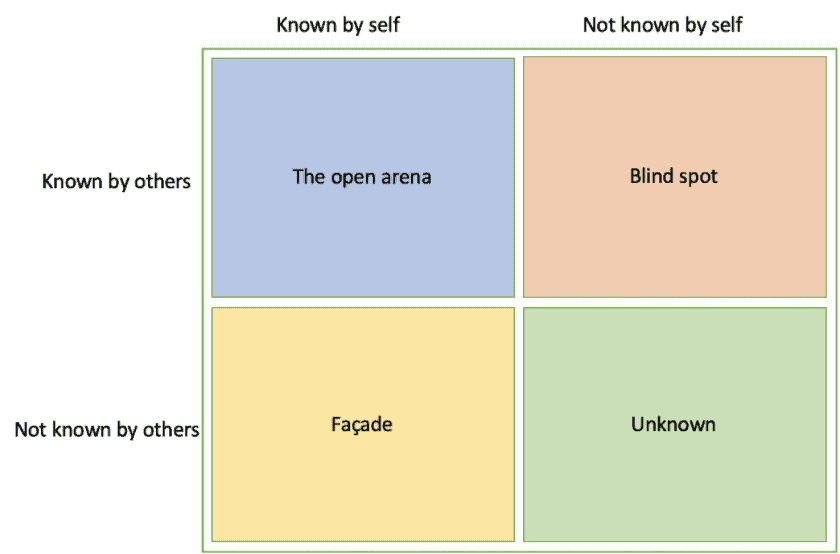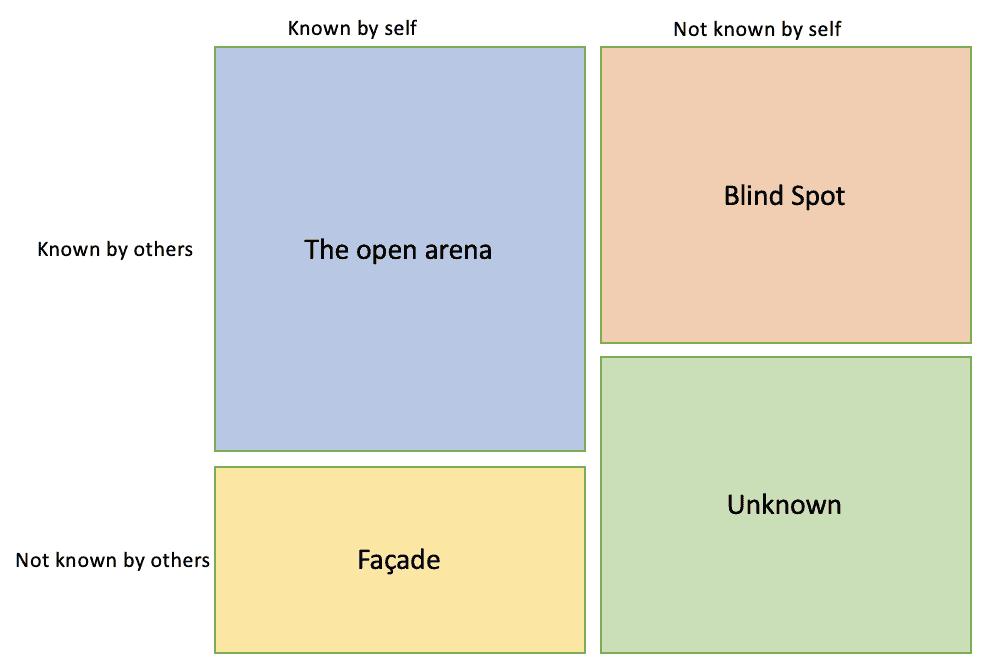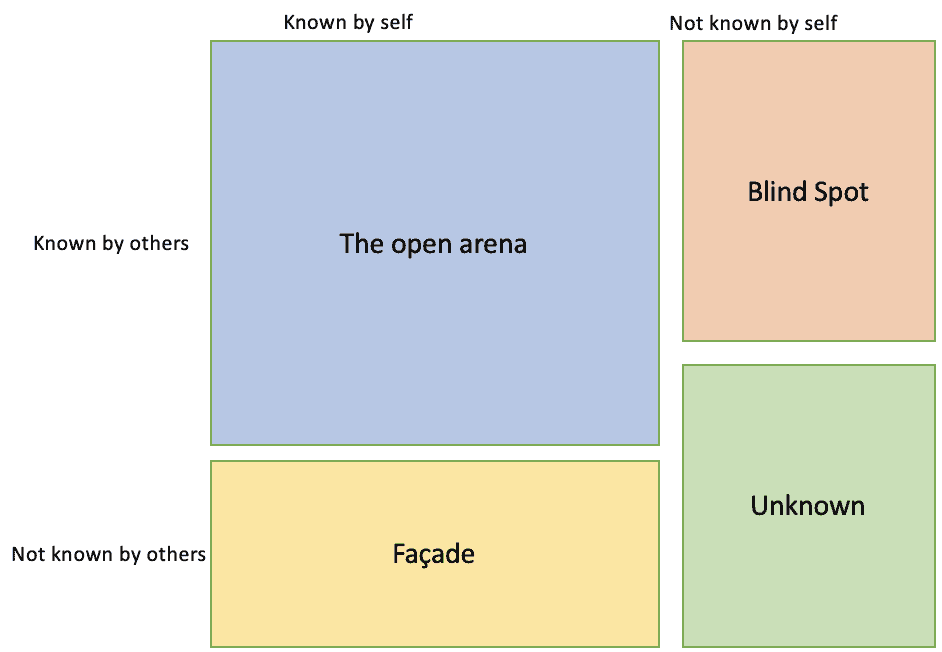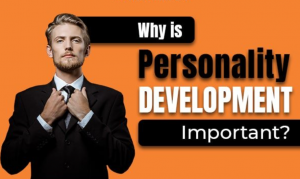Have you ever given a business presentation for a crowd? If so, you may have felt stressed, anxious or nervous. Or, maybe you felt that your presentation didn’t go over very well and there were some blank stares and exhausted yawns from the audience. You may be surprised to know that all of the basic elements of communication can be summarised into a simple theory. In this blog, we’ll look at the Johari Window Model and its four quadrants. It’s a psychology model that helps us better understand how we can create deeper relationships through communication.
The model is based on the concept of awareness that is felt by you (the communicator) and other people (who you are speaking to). It defines “where” information lies when two or more people are communicating.
What is the Johari Window?
The Johari Window is a model that helps us understand our relationships with ourselves and others as we interact with them. It offers insights into both our known and hidden behaviors, thus facilitating clearer communication and fostering mutual trust in interpersonal dynamics.
History and Origins of the Johari Window Model
In group settings, fostering self-awareness and personal growth is crucial. The Johari Window serves as an effective tool for bolstering communication and mutual understanding among group members. This model came to fruition in 1955, thanks to the efforts of American psychologists Joseph Luft and Harry Ingham. Its inception was influenced by group dynamics studies at the University of California, with further refinements made by Joseph Luft. The moniker “Johari” is a fusion of the creators’ first names. Often, it’s also referred to as a model for feedback and self-disclosure.
The Four Quadrants of the Johari Window
The Johari Window model diagram literally looks like a window with four quadrants. The terms used in the diagram go along with the “pane” of window which they represent.

There are four assumptions that we must make when using this diagram:
- There is information that is known to only me.
- There is information that is known to only you (or, whoever you’re communicating with).
- There is information that is known to you and me.
- There is information that neither of us know.
Note that the sizes of the window panes can change based on where the information is at any given point depending on how well you know yourself, and how well others know you.
1. Arena or Open Area
While you speak with someone, there are things that both you and the person you’re talking to are aware of. Communication coach Alex Lyon describes this as the “I know, You know” open area pane.
This includes information about the person such as their attitudes, behaviour, emotions, feelings, skills and views that are known by the communicator and the person or people they are talking to.
If you are giving a speech, a panellist introduces your name, title, qualifications, how long you’ll be speaking for and the subject matter to the crowd. Now each person in the room (including yourself) is aware of each of these items. These facts are in the open area arena in the Johari window model.
Feelings and desires can also be collectively known by yourself and others. For example, if you are sitting in an audience after watching four hours of lectures, everyone in the room probably knows that lunch is about to be served and there is little attention being paid to the speaker.
This is the main open area where communication incurs. The larger the open area arena is, the more effective the communication is; this leads to deeper and more authentic relationships.
2. Facade
The next panel is the facade or hidden area – items that are known to you but not to others. Things in this quadrant are attributes and personal details that you know about yourself that are not known to others.
Depending on the situation, it might be better to reveal things about yourself from the hidden area to build trust and move the communication window closer to the “open” arena.
To use the example of a speaking engagement, in the introductory remarks of your speech, you might want to describe something memorable about yourself to build rapport with the audience. Mentioning a fun fact or talking about a personal hobby that’s related to the subject of the speech might be a good ice-breaker according to the Johari window model.
Communication coach Alex Lyon says that letting people know you can break down communication barriers and build stronger relationships, whether that be with an audience or with a close friend.
By telling the audience about yourself, the Open Arena pane grows, and becomes bigger than the Facade pane as shown in the image:

Communication coach Alex Lyon says that letting people know you can break down communication barriers and build stronger relationships, whether that be with an audience or with a close friend is important in the Johari window model.
3. Blind Spot
The third quadrant of the Johari Window model is the blind spot – things that you are not aware of but other people can see or understand, this is a barrier to self awareness.
In the example of public speaking, you may develop some physical and unconscious habits. Things like rubbing your hands through your hair or averting eye contact with the audience are physiological responses to being nervous. You probably don’t know that you’re doing these things, meaning you’re in the blind area to them despite that the people in the crowd can observe you doing them.
One way to correct these unconscious behaviours, in terms of public speaking, is to ask a colleague or a coach for feedback that helps your own self awareness.
If you have ever travelled to another country, you may have experienced the blind area firsthand. Living or working in a different cultural setting brings out your blind spot because it forces you to recognize your everyday habits and expectations. For example, a businesswoman from New York might not realize how inherently impatient she is until she travels to Spain, where life is more relaxed and less rushed, this helps people reduce the size of the blind area.
By understanding yourself better, the Open Arena in the Johari window model will be wider, as shown in the image:

This happens in everyday conversation. In all of your relationships, people notice things about your blind area that you probably do not know about yourself. You can use this to figure out what others think about you, and being open to that feedback can help you grow. To help reduce your blind spot and improve communication outside of work, you can ask your friends and family about the characteristics they see in you. Maybe even make it a game to get them to open up and show them this post about the Johari window model.
It is important to note that these things can be positive too. If you give a really great introduction to your presentation, then knowing that is a strength can help you capitalize on it in the future. Likewise, if a friend tells you that she thinks you’re a very conscientious worker, then own it and use it to your advantage.
Learning more about yourself helps people to become a more well-rounded person.
4. The Unknown area
The last panel of the Johari Window model occurs when there are things that both you and others aren’t aware of while you’re speaking to one another.
How do we know this even exists?
Well, information is always waiting to be discovered. We know this because there is always new information to be learned about ourselves, others, and the world.
For example, two coworkers Eleanor and Jack are talking about where they want to eat lunch. Eleanor asks, “Jack, do you like Nando’s?” Jack has never eaten at Nando’s, so he does not know if he likes Nando’s. Nobody knows if Jack likes Nando’s, until Jack actually tries it.
The key to this is that new experiences teach us things about ourselves and others that would not have been known otherwise. Breaking into the Unknown area pane of the Johari Window model can help us get out of our comfort zone and understand the world a bit better.
It can be a challenge to bring awareness to the emotions, stresses, feelings and thoughts that exist in the Johari Window unknown quadrant, but it’s not impossible. We’ll look at some techniques below, using the Johari Window matrix, to promote open communication for any situation you might find yourself in.
Examples of the Johari Window Model
Imagine Jack, a fresh face in the bustling landscape of a renowned marketing firm.
Scenario 1
When Jack stepped into the firm, most colleagues only knew his name and role, nothing more. The vast majority of Jack’s persona was either hidden or unknown to them, with only a sliver in the open area. Jack was essentially an enigma, with a vast territory uncharted by his peers. This early stage could be visualized as Figure 1 of the Johari Window.
Scenario 2
A few weeks in, during an informal team lunch, Jack picked up a guitar and played a soulful tune. This newfound talent shifted some of his unknown area into the open quadrant. Concurrently, a coworker gently pointed out Jack’s tendency to speak very softly, making it hard for others to hear him during meetings – a trait Jack was unaware of, his blind spot. Recognizing this, Jack made efforts to project his voice, expanding the open area further and reducing his blind spot. The transformation could be illustrated as Figure 2.
Outcome: As days turned to months, the continuous feedback and voluntary sharing nudged Jack to adjust, evolve, and foster deeper connections with his team. The interplay of the Johari Window quadrants played a pivotal role in bridging gaps and enhancing mutual understanding.
Considerations of the Johari Window Model
Disclosure is good for you
Being more in the open area leads to better communication. As more facts, emotions and motivations are brought to light, trust is built between the audience and the communicator. To learn more about what motivates you, read about theories of motivation and our motivational blog.
Use common sense
While openness is a good policy, it doesn’t mean that everyone needs (or wants) to know all your intimate details. Be careful who you tell your secrets to and respect the privacy of yourself and others.
Be short and sweet
Whether speaking to a crowd or in a one-on-one situation, only divulge what you think is important to build rapport or get your point across, have enough self awareness to know when to stop sharing or listen to the feedback from others if this is a blind spot to enable your own self discovery.
Fluctuations occur
Over the course of even a single conversation, the window will open and retract depending on what is said or brought to attention by yourself or others.
Growth and improvement happen
Remember that your characteristics, habits and attributes change over time. Your own communication abilities, as well as the relationships you uphold, evolve over time through self-coaching and grow as you become more in-tune with yourself and others.
Ask others to observe you
Sometimes the only way to expand your communication window into the open arena is to ask others to watch for your habits. Doing so is a good way to eliminate the “unknown” Johari Window quadrant since both you and who you’re speaking to will become aware of the growth potential.
I hope this helps you understand the Johari Window model, open area, hidden area, blind area and unknown area. Learning the Johari model can help you become a better communicator with a much higher level of self awareness and helps you enjoy more self discovery. This is a useful tool in training setting as group dynamics and group development are hugely influenced by how open or closed people in the group are.








